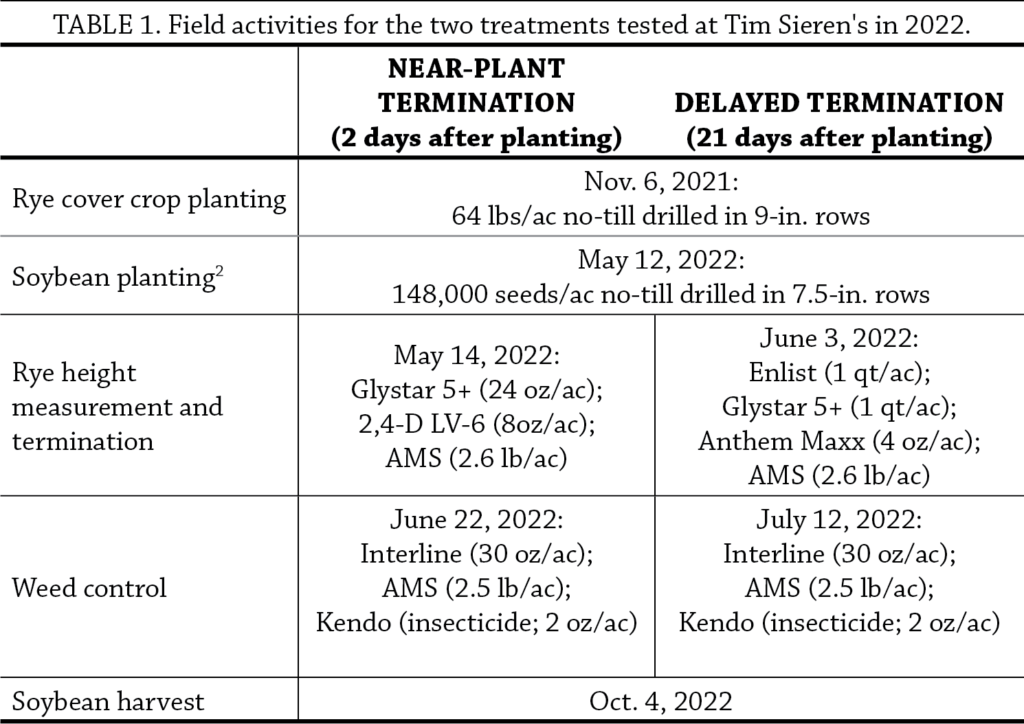This research was funded by Walton Family Foundation.
In a Nutshell:
- Tim Sieren wanted to maximize the weed suppressive benefits of a rye cover crop before his soybean crop in his no-till system. He knows more rye biomass often equates to better weed suppression.
- The objective of this trial was to determine whether delaying the rye cover crop termination a full month after soybeans have been planted impacts the subsequent soybean yields.
- Sieren hypothesized that while this delayed termination tactic may result in a scary looking soybean crop early on, it would not affect yields.
Key Findings:
- Terminating the rye cover crop three weeks after soybean planting resulted in 956 additional growing degree days compared to terminating at soybean planting and increased the cover crop height from 10 inches to 48 inches.
- The soybean yields in the delayed rye termination treatment were not significantly different from those in the treatment where rye was terminated near soybean planting.
- Sieren noted he was ‘pulling his hair out’ when he had to hunt for his soybeans in a field of rye residue in late June, well into a drought year. But in the end after seeing his yields he noted “my no-till beans told me once again: Don’t worry…be happy! Soybeans and rye can get along in almost any conditions, at any growth stage!”
Background
Several Practical Farmers of Iowa farmer collaborators have experimented with terminating their over-wintering rye cover crops after planting their soybean crop (although this is not allowed under federal crop insurance rules). Multiple experiments have been conducted under this theme.[1-3] As farmers have gotten more comfortable with this delayed cover crop termination tactic, they have wondered how they can tweak their herbicide regimes to take advantage of the higher amounts of rye biomass.[4] Tim Sieren has previously participated in delayed termination experiments, and this year he wanted to get more experience and think about how he might adjust his herbicide regimes in a ‘delayed’ termination setting.
“[The experiment] will help determine how I can change my current practices to raise soybeans more efficiently by reducing herbicide costs,” Sieren said. With the help of Practical Farmers of Iowa, Sieren turned to an on-farm experiment to help him do that.
Methods
Design
On Nov. 6, 2021 Sieren no-till drilled 63.7 lb/ac cereal rye (variety not stated; VNS) into corn stubble in 9-in. rows as a cover crop. The following spring Sieren compared two rye termination treatments:
- Near-plant: Rye cover crop was terminated two days after planting a soybean crop
- Delayed: Rye was terminated 21 days after planting a soybean crop
Sieren replicated each treatment four times, for a total of eight plots (Figure A1). Each treatment plot was the width of Sieren’s combine header and ran the length of the field. The different termination dates were accompanied by different weed management regimes, but the plots were otherwise managed the same (Table 1). Sieren looked at the effect of the two treatments on both cover crop biomass and subsequent soybean yields.
Measurements
The day he terminated the cover crops, Sieren measured the rye heights and recorded the average for each treatment. Sieren also recorded the soybean yields from each plot.
Weather
To add some context to the rye height measurements, we calculated the number of growing degree days (GDDs) the rye accumulated from Jan. 1, 2022 through the termination date, using 32 degrees Fahrenheit (deg F) as the base temperature. Using this methodology, the average daily air temperature is calculated for each day individually using weather data. A value of 32 is subtracted from the mean, resulting in the total GDDs accumulated that day. Negative GDDs are assumed to add 0 GDDs for that day.
Data analysis
To evaluate the effects of termination timing in relation to soybean planting on soybean yields, we performed a t-test on each measurement to test whether there was an effect of the treatment on the recorded yields. Additionally, we calculated the smallest measurement difference required to say with 95% confidence that there was an effect of the treatment (commonly referred to as the least-significant-difference; LSD).
Results and Discussion
Soybean yields, cover crop growing degree days, cover crop height
The rye from the ‘delayed’ termination treatment (21 days after soybean planting; DAP) accumulated more than twice the number of GDDs compared to the ‘near-plant’ termination treatment (2 DAP), which was reflected in the quadrupling of rye height (Figure 1). This difference in rye growth was striking, as seen in the photos from June immediately prior to terminating the ‘delayed’ treatment.
The subsequent soybean yields were not significantly different, with the ‘near-plant’ treatment yielding 66 bu/ac and the ‘delayed’ 67 bu/ac. Sieren would have needed to see a difference greater than 6 bu/ac to be 95% confident his treatment had an effect.
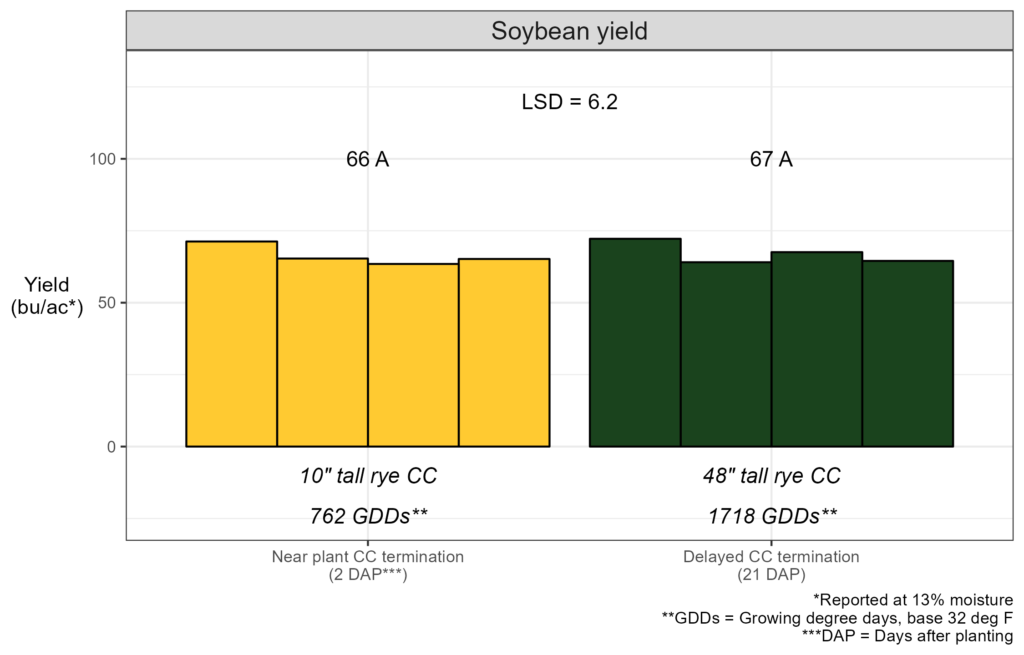
Figure 1. Soybean yields from Tim Sieren’s two rye cover crop (CC) termination treatments, values followed by the same letter indicate no significant difference. The least-significant-differences (LSDs; top), rye height, and rye growing degree days (GDDs; bottom) are presented for context.
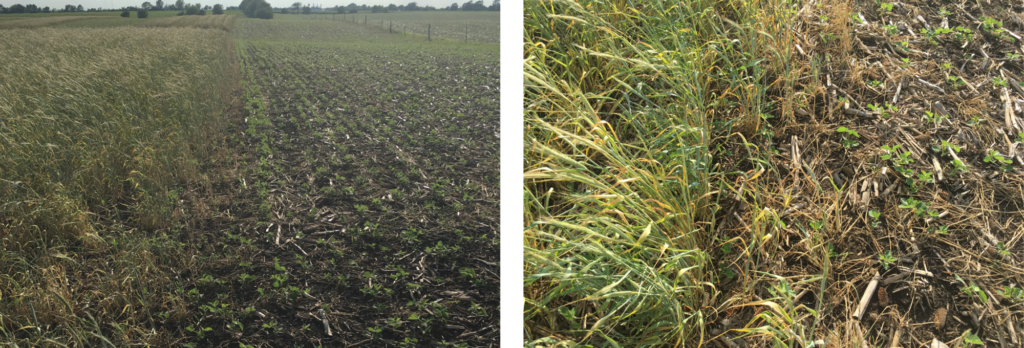
The ‘delayed’ rye termination treatment was terminated three weeks after soybean planting (left) compared to the ‘near-plant’ treatment which was terminated near soybean planting. (Right) Close-up of treatments, showing the drastic differences in rye biomass and soybean visibility. Both photos taken June 8, 2022.
Observing the soybeans was a roller coaster of emotions for Sieren. When he terminated the rye in his ‘delayed’ treatment in June, the soybeans were at the V2/V3 growth stage and were barely visible. They were burned and set back around 2 or 3 weeks (chemical dealers have received bulletins about this from the Enlist manufacturer).
As he reflected on the season, Sieren noted his worry. “I thought I’d shot myself in the foot by terminating [the cover crop] late this year…it seemed like the beans were stunted, and just wouldn’t grow, and you couldn’t see any beans in the tall rye until late June.” Sieren waited until July 1, and given the dry conditions, he decided to leave it be and not attempt a re-plant.
Sieren was pleasantly surprised to find that in the end, the soybean yields were not different. “My no-till beans told me once again: Don’t worry…be happy!” he noted. “Soybeans and rye can get along in almost any conditions, at any growth stage!”
Conclusions and Next Steps
Sieren plans to change the timing of his delayed cover crop termination in relation to the soybean planting to reduce the stress on the early soybeans. While he originally wanted to see how the delayed termination would impact the weeds, he felt the drought had too large of an impact on the results for him to say anything definitive on that front. As weather stress becomes more common, he is interested in understanding how he can adjust his management when he knows a drought is imminent. “There needs to be a way to determine when moisture stress is most detrimental to yields,” he says. This statement certainly seems to foreshadow another on-farm trial.
Appendix – Trial Design and Weather Conditions
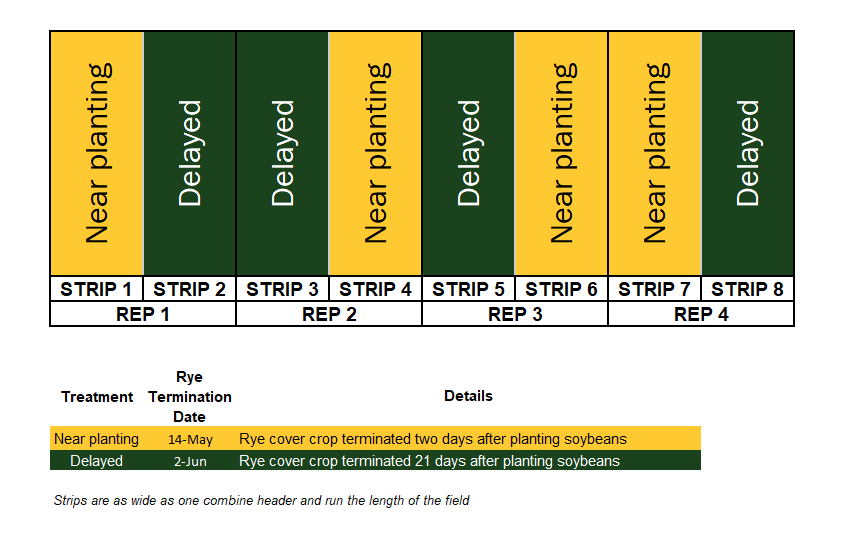
Figure A1. Tim Sieren’s experimental design consisted of four replications of the two treatments (8 strips total). This design allowed for statistical analysis of the results.
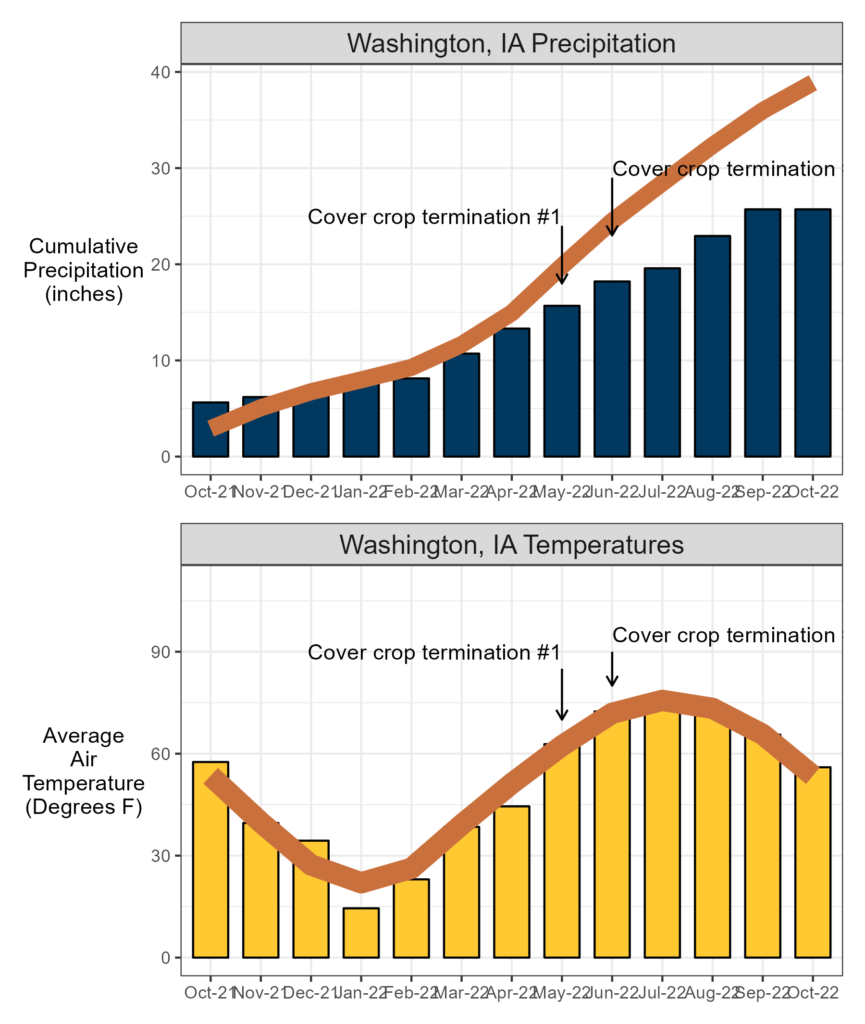
Figure A2. Fifty-year average (orange line) and experimental year (bars) weather data at the nearest weather station to the study site in Washington, IA from October 2021 through soybean harvest in October 2022.[5] (Top) Cumulative precipitation, which shows the 2022 summer drought conditions. (Bottom) Average monthly air temperature.
References
- Gailans, S., J. Boyer and T. Sieren. 2019. Terminating Cereal Rye After Planting Soybean. https://practicalfarmers.org/research/terminating-cereal-rye-cover-crops-after-planting-soybeans/ (accessed December 2022).
- Nelson, H., J. Bakehouse and S. Bennett. 2020. Terminating Cereal Rye After Seeding Soybean (Or Not!). https://practicalfarmers.org/research/terminating-cereal-rye-after-seeding-soybeans-or-not/ (accessed December 2022).
- Nelson, H. and D. Sloan. 2021. Terminating Cover Crops After Seeding Soybeans. https://practicalfarmers.org/research/terminating-cover-crops-after-seeding-soybeans/ (accessed December 2022).
- Gailans, S. and S. Bennett. 2019. Cover Crops for Reducing Herbicides in Soybeans. https://practicalfarmers.org/research/cereal-rye-cover-crop-for-reducing-herbicides-in-soybeans-2019/ (accessed December 2022).
- Iowa Environmental Mesonet. 2022. Climodat Reports. Iowa State University. http://mesonet.agron.iastate.edu/climodat/ (accessed December 2022).


